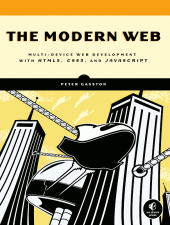"This is a useful book, and it's an important book. If you follow Peter Gasston's advice, then test your sites across all browsers and on a variety of devices, you’ll impress your bosses and please your users. You'll also be making the Web better and keeping it open."
—Bruce Lawson, author of Introducing HTML5
"Peter Gasston has now done for the modern web platform what he already did for CSS: write a consult-it-first compendium of information for web developers of practically any skill level."
—Stephen Hay, author of Responsive Design Workflow
"Peter Gasston strikes a great balance between producing fantastic real-world code and staying right on top of the latest developments in web technology. He has a considerable gift for explaining difficult technical topics in a lucid and entertaining manner."
—Chris Mills, developer relations manager, Opera Software and author of Practical CSS3
"I learned a lot of new stuff reading this. Top notch, useful stuff that I have already put into play in sites I am working on. Stuff that I hadn't come across, even with all the reading and searching that I do. If you are a builder of modern web sites then I reckon you need this book."
—Jane Morrison, FLOSS UK Secretariat
"The Modern Web should be on every web developer’s bookshelf!"
—Raj Sharma, British Computer Society (Read More)
"The Modern Web is not only a great reference, it's very readable. It's well indexed, the examples are short, sweet, and to the point, and the style is conversational."
—Lynn Greiner, SmartBear (Read More)
"The Modern Web is a pleasant read. Peter writes in plain and simple English, making the reader enjoy the information instead of falling asleep with boring technical stuff. Peter's straight forward way of teaching modern coding methods is nice and engaging."
—Gisele Muller, Abduzeedo (Read More)
"If you're willing to give up your old ways of building web pages and embrace more modern techniques, then this book is a great addition to your library. The additional resources included in every chapter and in the final appendix are invaluable."
—Jennifer Kyrnin, About.com Web Design/HTML (Read More)
"As a front-end developer, it is important to have an understanding of the context we work in, user trends, technological developments, and the tools that are already at our disposal or will be soon. . . . If you only read one book on the latest developments in HTML5, CSS3, and JavaScript this year, this is the one."
—Chris Webb, front-end developer at Funda (Read More)
"This is a well-written book. In a clear and accessible manner, Gasston leads you through several chapters detailing the latest technologies and thinking in modern web design."
—Virginia DeBolt, Web Teacher (Read More)
"The author has a really nice writing style which makes the book an enjoyable read. He covers a ton of topics and covers them deep enough to thoroughly explain how to use them."
—Tad Anderson, SYS-CON MEDIA (Read More)
"If you get excited by clever CSS techniques, semantic markup, and different ways you can use APIs to interact with users, The Modern Web is the book for you."
—David Indish, Red Star Web Development (Read More)
"Essential reading for any web developer."
—Craig Buckler, Optimal Works (Read More)
Featured in HTML 5 Weekly!

